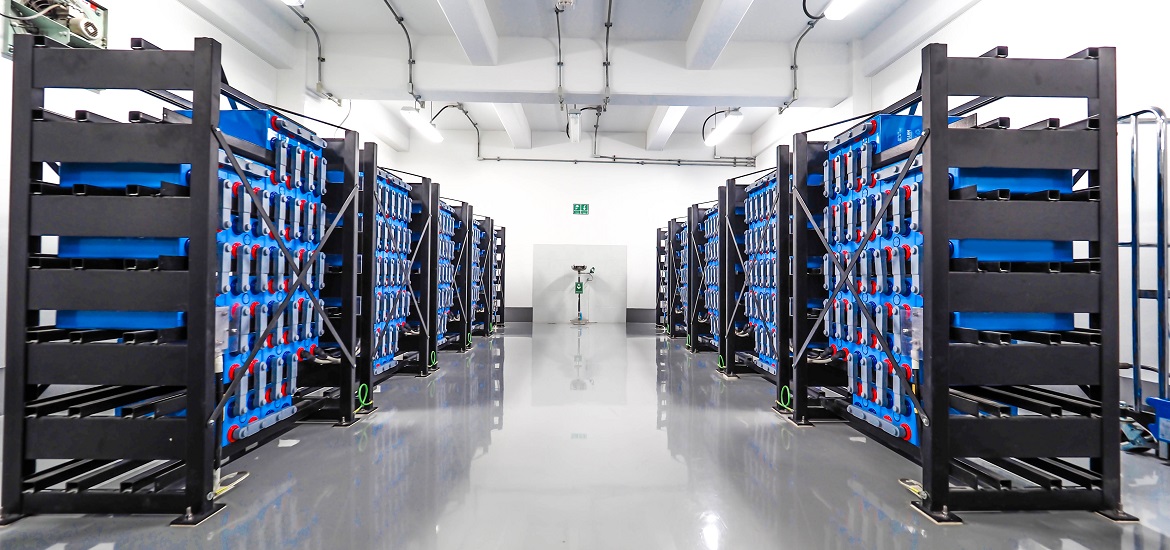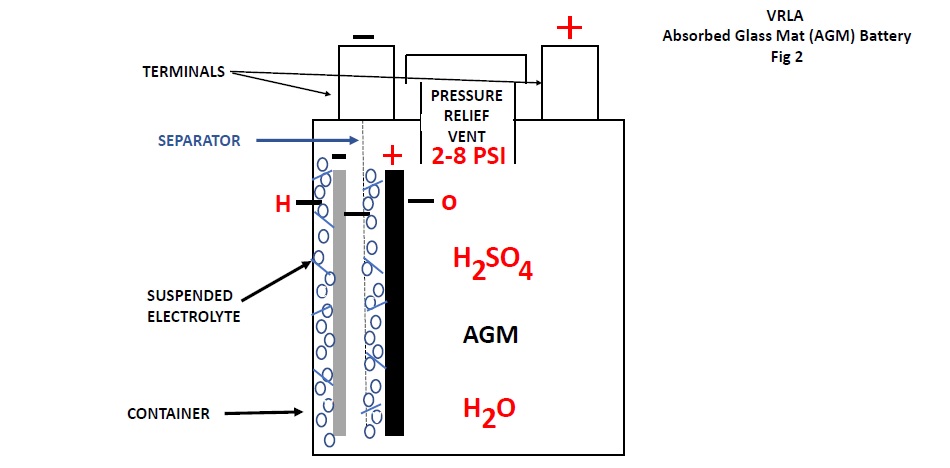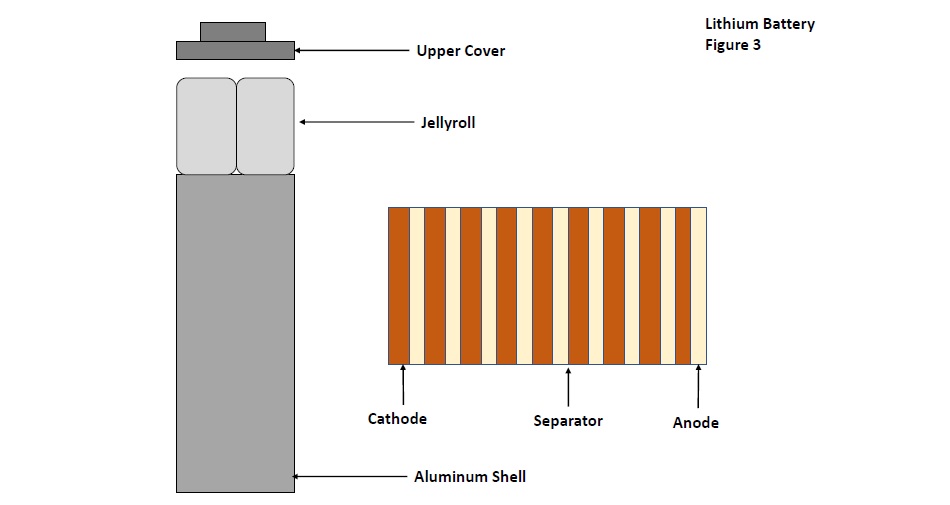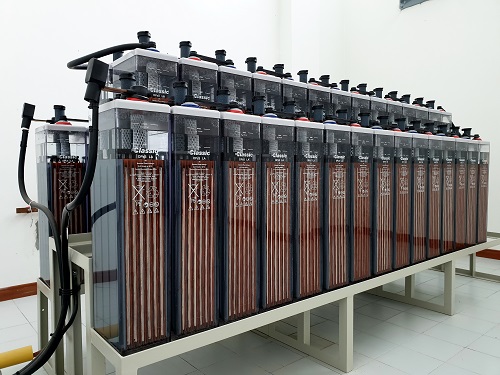
Photos: Shutterstock.com; Figures: H2scan
HYDROGEN MANAGEMENT
Best practice standards such as IEEE documents and fire code state that you must deal with hydrogen in one of two ways: 1) Prove the hydrogen evolution of the battery (using IEEE 1635 / ASHRE 21), or 2) have continuous ventilation in the battery room. Vented Lead Acid Batteries (VLA) are always venting hydrogen through the flame arrester at the top of the battery and have increased hydrogen evolution during charge and discharge events. Vented Lead Acid Batteries (VRLA) batteries are 95-99% recombinant normally, and only periodically vent small amounts of hydrogen and oxygen under normal operating conditions. However, both types of batteries will vent more hydrogen during equalize charging or abnormal charge conditions.
Vented Lead Acid (VLA) and vented Ni-Cad (Ni-Cad) batteries are either fully vented or partially recombinant battery types (Figure 1). They are batteries with free-flowing liquid electrolyte that allows any gasses generated from the battery during charging to be directly vented into the atmosphere. Partially recombinant batteries will contain a catalyst device in place of the flame arrestor and will result in half of the hydrogen released into the atmosphere. In abnormal conditions, greater amounts of hydrogen gas will be released into the atmosphere.

Figure 1. VLA Cell Vented Lead Acid Battery
VRLA battery is designed to be a non-spillable, recombinant battery. Each cell is designed with a one-way pop-up valve that is incorporated into the container (jar) to prevent gas build up (Figure 2). During normal operation, this valve remains in the closed position, trapping the hydrogen gas allowing for the recombination process to reduce water loss in the battery. The valve will remain closed if the pressure remains under the manufacturer’s specification which is typically around 5 psi. However, the valve may open during recharge, equalize charge or any abnormal charge condition causing hydrogen to escape into the cabinet or room causing the potential for fire and/or explosion. This is caused by additional current that results in more recombination and heat generation that has the potential to lead to thermal runaway and greater hydrogen evolution of the battery.

Figure 2. VRLA Absorbed Glass Mat (AGM) Battery
Lithium batteries are non-aqueous electrolyte batteries (Figure 3). The cells are sealed and will not vent unless they have a thermal runaway event. During thermal runaway, considerable amounts of Carbon Dioxide, Carbon Monoxide, and Hydrogen. Depending on the Lithium battery chemistry, other combustible gasses such as Hydrogen Fluoride, methane, ethane, propylene, ethylene, etc. will be produced. Lithium-Ion batteries are equipped with a Battery Management (BMS) system that controls the state of charge and monitors battery parameters but cannot control a thermal runaway event resulting from an internal short.

Figure 3. Lithium Battery
Codes & Standards
Standards provide minimum requirements and/or instructions in agreement within the industry for common reference. Common standards in the battery room include those from Electrical and Electronic Engineers (IEEE), and National Fire Protection Association (NFPA).
Model codes are developed by committees with the intent to be adopted by states and local jurisdictions. Subject matter experts develop voluntary consensus standards that are saving the jurisdictions time and money by creating an industry-wide standard to follow. Once the model codes are adopted, they are enacted into law and become code.
IEEE Standards
The IEEE 1635 ASHRE 21 standard explains the hydrogen evolution per battery type and potential heat and off-gassing types.
For example, VLA battery rooms can reach 2% rise in hydrogen concentration with just half a day of equalize operation and three days normal float operation. Calculations may be found in the IEEE Std P1635™ IEEE/ASHRAE Guide for the Ventilation and Thermal Management of Batteries for Stationary Applications.
Fire Code
The minimum to comply with Fire Code for ESS Lead Acid Batteries is 70 kWH for Lead-acid and Ni-Cad battery types. All systems exceeding this value must comply with fire code.
To prevent fires and explosions, best practice standards such as IEEE documents and fire code state that you must deal with hydrogen in one of two ways: 1) Prove the hydrogen evolution of the battery (using IEEE 1635 / ASHRE 21), or 2) have continuous ventilation in the battery room.
Hydrogen detection is described in the International Fire Code section 1207.6.1. Hazardous mitigation plans determine the need for hydrogen detection and evacuation to limit maximum concentration to 25% Lower Flammability Limit (LFL) or 1% of total room volume.
However, continuous ventilation may be avoided by installing continuous H2 monitoring and adding to your Hazardous Mitigation Plan.
According to section 1207.6.1.2.4, gas detection systems are required to contain the following features:
-
Activate a mechanical exhaust ventilation system

-
Ensure ventilation systems to remain on until gas detected is below 25% LEL
-
Gas detection system shall have 2 hours of standby power in accordance with section 1203.2.5
-
Failure of the gas detection system shall annunciate a trouble signal (NFPA 72) or audible and visible trouble signal at an approved constantly attended on-site location
Note: The State or Local Authorities Having Jurisdiction (AHJ) may require more than what is stated in the model codes.

Traditional catalytic bead sensors for area sensing require calibration every 3-6 months and replacement every 3-5 years. Industry experts, and Authorities Having Jurisdiction (AHJ) always been concerned about end-user maintenance practices to achieve accurate hydrogen sensing.
New and improved sensors contain solid state, auto calibrating technology that is more advanced than legacy sensors that drifts or loses its sensitivity over time. These new technology sensors are made from precious metals that are not consume over time which is a game-changer in the industry. These long lasting, maintenance-free solution last over 10-years that give facility managers and AHJs renewed confidence in hydrogen sensing for battery rooms.
These long lasting, maintenance-free solution last over 10-years that give facility managers and AHJs renewed confidence in hydrogen sensing for battery rooms.
Resources
-
Heinsdorf, H. P.E. (2015) Code or standard? Retrieved from https://www.csemag.com/articles/code-or-standard/v
-
Wisdom Industrial Power, (2020) What is valve regulated lead acid battery? Retrieved from https://www.bullsbattery.com/industry-news/what-is-valve-regulated-lead-acid-battery.html
-
EHS-DOC-146 v.1 (2018) Retrieved from https://www.concordia.ca/content/dam/concordia/services/safety/docs/EHS-DOC-146_LeadAcidBatteries.pdf
-
E. Galushkin, N.N. Yazvinskaya, D.N. Galushkin (2019) Mechanism of Gases Generation during Lithium-Ion BatteriesCycling. Retrieved From: https://www.researchgate.net/publication/331793712_Mechanism_of_Gases_Generation_during_Lithium-Ion_Batteries_Cycling
-
International Fire Code 2021
-
Powershield (2019) Thermal Runaway and Thermal Walkaway. Retrieved from https://info.powershield.com/blog/thermal-runaway-thermal-walkaway












